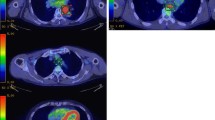Abstract
Purpose
To determine the preoperative ability of [18F]-fluoro-2-deoxyglucose positron emission tomography (FDG-PET) to predict pathologic tumor invasion and lymph node status in cT1N0M0 esophageal squamous cell carcinoma (ESCC).
Methods
We retrospectively analyzed 40 consecutive patients diagnosed with cT1N0M0 ESCC between February 2006 and April 2011. All patients were treated by esophagectomy with two- or three-field lymphadenectomy without neoadjuvant therapy. We evaluated the relevance between clinical variables including maximum standardized uptake values (SUVmax) of the primary tumor on FDG-PET and pathologic tumor invasion and lymph node status using a logistic regression model.
Results
Tumors invaded the middle submucosal layer (SM2) and beyond in 21 (52.5 %) patients, and 6 (15 %) had lymph node metastases. The areas under receiver operating characteristic (ROC) curves for SUVmax of the primary tumor used to predict factors involved in tumor infiltration to SM2 or deeper and lymph node metastasis were 0.75 (p = 0.006) and 0.79 (p = 0.025), respectively. The optimal SUVmax cutoff was 2.7. The findings of univariate and multivariate analyses identified SUVmax as the only significant preoperative predictor associated with tumor infiltration into SM2 or beyond and lymph node metastasis. Furthermore, SUVmax ≥ 2.7 of the primary tumor on FDG-PET was associated with poor recurrence-free and disease-specific survival (p = 0.019 and p = 0.012, respectively).
Conclusions
FDG-PET is helpful for diagnosing tumors that can infiltrate SM2 and beyond as well as occult lymph node metastasis of cT1N0M0 ESCC that are valuable indications in deciding therapeutic strategies for superficial ESCC.

Similar content being viewed by others
References
Endo M, Kawano T. Detection and classification of early squamous cell esophageal cancer. Dis Esophagus. 1997;10:155–8.
Fujishiro M, Yahagi N, Kakushima N, et al. Endoscopic submucosal dissection of esophageal squamous cell neoplasms. Clin Gastroenterol Hepatol. 2006;4:688–94.
Fujita H, Sueyoshi S, Yamana H, et al. Optimum treatment strategy for superficial esophageal cancer: endoscopic mucosal resection versus radical esophagectomy. World J Surg. 2001;25:424–31.
Shimizu Y, Tsukagoshi H, Fujita M, Hosokawa M, Kato M, Asaka M. Long-term outcome after endoscopic mucosal resection in patients with esophageal squamous cell carcinoma invading the muscularis mucosae or deeper. Gatrointest Endosc. 2002;56:387–90.
McGuill MJ, Byrne P, Ravi N, Reynolds J. The prognostic impact of occult lymph node metastasis in cancer of the esophagus or esophago-gastric junction: systematic review and meta-analysis. Dis Esophagus. 2008;21:236–40.
Rigo P, Paulus P, Kaschten BJ, et al. Oncological applications of positron emission tomography with fluorine-18 fluorodeoxyglucose. Eur J Nucl Med. 1996;23:1641–74.
Kato H, Kuwano H, Nakajima M, et al. Comparison between positron emission tomography and computed tomography in the use of the assessment of esophageal carcinoma. Cancer. 2002;94:921–8.
Guo H, Zhu H, Xi Y, et al. Diagnostic and prognostic value of 18F-FDG PET/CT for patients with suspected recurrence from squamous cell carcinoma of the esophagus. J Nucl Med. 2007;48:1251–8.
Brücher BL, Weber W, Bauer M, et al. Neoadjuvant therapy of esophageal squamous cell carcinoma: response evaluation by positron emission tomography. Ann Surg. 2001;233:300–9.
Downey RJ, Akhrust T, Ilson D, et al. Whole body 18FDGPET and the response of esophageal cancer to induction therapy: results of a prospective trial. J Clin Oncol. 2003;21:428–32.
Japanese Society for Esophageal Diseases. Guidelines for the clinical and pathologic studies on carcinoma of the esophagus. 10th ed. Tokyo: Japanese Society for Esophageal Diseases; 2007.
Kodama M, Kakegawa T. Treatment of superficial cancer of the esophagus: a summary of responses to a questionnaire on superficial cancer of the esophagus in Japan. Surgery. 1998;123:432–9.
Matsubara T, Ueda M, Abe T, Akimori T, Kokudo N, Takahashi T. Unique distribution patterns of metastatic lymph nodes in patients with superficial carcinoma of the thoracic oesophagus. Br J Surg. 1999;86:669–73.
Shimada H, Nabeya Y, Matsubara H, et al. Prediction of lymph node status in patients with superficial esophageal carcinoma. Analysis of 160 surgically resected cancers. Am J Surg. 2006;191:250–4.
Lee JR, Madsen MT, Bushnel D, Menda Y. A threshold method to improve standardized uptake value reproducibility. Nucl Med Commun. 2000;21:685–90.
Kuwano K, Nishimura Y, Ohtsu A, et al. Guidelines for diagnosis and treatment of carcinoma of the esophagus. April 2007 edition: part I. Edited by the Japan Esophageal Society. Esophagus. 2004;5:61–73.
Higuchi K, Tanabe S, Koizumi W, et al. Expansion of the indications for endoscopic mucosal resection in patients with superficial esophageal carcinoma. Endoscopy. 2007;39:36–40.
Katada C, Muto M, Momma K, et al. Clinical outcome after endoscopic mucosal resection for esophageal squamous cell carcinoma invading the muscularis mucosae—a multi-center retrospective cohort study. Endoscopy. 2007;39:779–83.
Puli SR, Reddy JB, Bechtold ML, Antillon D, Ibdah JA, Antillon MR. Staging accuracy of esophageal cancer by endoscopic ultrasound: a meta-analysis and systematic review. World J Gastroenterol. 2008;14:1479–90.
Pech O, Gunter E, Dusemund F, Origer J, Lorenz D, Ell C. Accuracy of endoscopic ultrasound in preoperative staging of esophageal cancer: results from a referral center for early esophageal cancer. Endoscopy. 2010;42:456–61.
Pfau PR, Perlman SB, Stanko P, et al. The role and clinical value of EUS in a multimodality esophageal carcinoma staging program with CT and positron emission tomography. Gastrointest Endosc. 2007;65:377–84.
Okada M, Murakami T, Kumano S, et al. Integrated FDG-PET/CT compared with intravenous contrast-enhanced CT for evaluation of metastatic regional lymph nodes in patients with resectable early stage esophageal cancer. Ann Nucl Med. 2009;23:73–80.
Miyata H, Doki Y, Yasuda T, et al. Evaluation of clinical significance of 18F-fluorodeoxyglucose positron emission tomography in superficial squamous cell carcinomas of the thoracic esophagus. Dis Esophagus. 2008;21:144–50.
Tsutani Y, Miyata Y, Nakayama H, et al. Prediction of pathologic node-negative clinical stage IA lung adenocarcinoma for optimal candidates undergoing sublobar resection. J Thorac Cardiovasc Surg. 2012;44:1365–71.
Disclosure
The authors declare no conflict of interest.
Author information
Authors and Affiliations
Corresponding author
Rights and permissions
About this article
Cite this article
Furukawa, T., Hamai, Y., Hihara, J. et al. Clinical Significance of FDG-PET to Predict Pathologic Tumor Invasion and Lymph Node Metastasis of Superficial Esophageal Squamous Cell Carcinoma. Ann Surg Oncol 23, 4086–4092 (2016). https://doi.org/10.1245/s10434-016-5359-0
Received:
Published:
Issue Date:
DOI: https://doi.org/10.1245/s10434-016-5359-0




